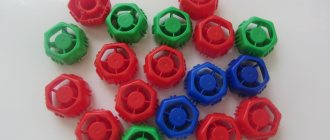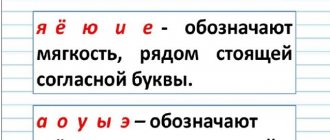When studying phonetics, schoolchildren, starting from the 1st grade, not only characterize sounds, but also divide words into syllables. Dividing words into syllables is somewhat difficult, and now we will find out how to complete the task without errors.
The material was prepared jointly with a teacher of the highest category
Kuchmina Nadezhda Vladimirovna.
Experience as a teacher of Russian language and literature - 27 years.
What are syllable tables and how to work with them?
Syllable tables are columns of different syllables:
open (na, lo, su), closed (tel, sun, lok) and a combination of 4-5 letters (slit, klyns)
All combinations of letters do not carry a semantic load, so all the child’s attention is focused on correct reading.
When working with syllable tables, keep in mind that:
- You can read it column by column, line by line, or separately.
- It is advisable to achieve uniform reading of syllables . To do this, you can use a metronome or tap out a rhythm that is comfortable for your child’s reading speed.
- We move from one table to another only when the previous one has been processed.
Types of exercises with syllable tables:
- Quickly read syllables horizontally and vertically.
- A child quickly finds a syllable that an adult has read.
- “Tell me the end of the word.” An adult pronounces a word without finishing the last syllable. The child finds it in the table, shows it and reads it.
When reading syllable tables, remember:
- You should not allow syllables to be read letter by letter, call consonant letters by sound, not by letter (For example, “M”, not “EM”);
- if a child has forgotten how to read the letters and cannot read a syllable, there is no need to remind the letters individually, it is better to just read to him the syllable on which he is stuck;
- the pace of mastering syllables should correspond to the child’s capabilities, since it is better to master a smaller number of consonants and corresponding syllables, but to automatically recognize and read the syllables;
- the skill of reading syllables of different types contributes to the fastest learning of a child to read whole words;
- it is necessary to increase the range of the field of view;
- If you have learned to quickly read a simple table, we begin to read a more complex table.
How to divide a word into syllables with a combination of consonants
How to divide a word into syllables if there are several consonants nearby in the middle? How to correctly break a word into syllables: cat or cat? You need to understand the principle of so-called greater sonority. It is observed in the second case. From consonant to vowel. First there is a dull sound, then a voiced consonant, and at the end a vowel - shka. The first syllable ends with a vowel (ko). Such syllables are called open. We have much more of them than those that end with consonants: table, chair (they are called closed syllables).
In the middle of a word, the syllable is usually open, that is, it ends with a vowel sound: stra-na. According to the principle of increasing sonority, all consonants move in most cases to the subsequent syllable: cat.
If several consonants are combined in the middle of a word, then all the consonants following the vowel go to the next syllable: o-flow. These can be the same consonants or simply combinations of different consonants: o-flow, sha-pka, ko-shka.
An exception to this point: only those syllables in the middle of a word that end with unpaired consonant voiced sounds (they are called very voiced, sonorant) end with a consonant: [й], [р], [р'], [л], [л '], [m], [m'], [n], [n']: may-ka, San-ka, man-ka.
If in a word several sounds merge into one sound, then they all go to one syllable: zhu-zhzh (Zh)at, distracted (CA). In these cases, one should not confuse division into syllables and morphemic division for transferring a word: for example, we divide o-teket by syllables, but for transfer we divide the same word like this - ot-tek.
How often to work with syllable tables?
Better every day . At least half an hour. Regular daily exercise will give you greater results than many hours once a week.
I'll tell you how I arrange syllable tables when working in 1st grade. This option is very convenient not only for printing, but also for use. What is needed for this:
- Take the most ordinary small photo album.
- Print syllabic tables.
- Insert into photo album.
- Start working on the resulting cute book.
The guys and I also insert tongue twisters into the same album for ease of use.
Children really like this option. They enjoy reading both during class and after class. Just like that, for myself. You can receive these 20 syllable tables as a gift when you purchase SPEED READING TRAINING.
But for a deeper and better study of the technique, I use the BIG BOOK OF SYLLABLE TABLES (syllable tables do not repeat the tables from the previous book).
THE BIG BOOK OF SYLLABLE TABLES is
- a ready-made tool for training reading and speed reading skills;
- 200 syllable tables of different levels of complexity;
- professional methods of working with tables.
The most effective methods will allow each table to be used multiple times, increasing the child’s interest in reading.
Working with these syllable tables, the child will receive:
- improving reading skills;
- increasing reading speed;
- improvement of diction;
- reading comprehension;
- development of thinking and attention;
- expansion of vocabulary;
- increasing self-confidence.
The child will stop stumbling over difficult words when reading. The reading process will become natural and painless.
You can easily print the necessary pages. All pages of the book can be used separately. THE BIG BOOK OF SYLLABLE TABLES is suitable for both those who are just taking their first steps in reading and those who want to significantly improve their reading quality.
How many syllables are in a word?
In Russian, the syllabic-forming function is performed by vowel sounds. Therefore, there are always as many logs in a word as there are vowels.
Although in some words one can observe an interesting phenomenon: with the sounds R and L there is, as it were, a small overtone and the word is pronounced as if there is another syllable ([t'a-tor] - theater); in Old Church Slavonic these sounds could form a syllable, but now such syllables “do not count.”
A syllable is a group of sounds that is pronounced together, in one impulse of air. Sometimes it is advised to take a lit candle and say a word next to it. How many times the flame flickers, there are so many lairs in a word.
The results of this experiment are not always accurate: for example, the word “ay” has two syllables, and the flame flickers only once.
Therefore, it is better to navigate not by flame or pronunciation, but by the number of vowels in a word.
How to make a child want to read?
For a child who still reads syllables, the process of reading is a lot of work. At this moment it is very important not to force, but to interest the baby!
Especially for this period, I wrote small but interesting educational texts. All words are divided into syllables. Each test has questions that help you understand how much your child understands what they read. Complete answers to the questions asked will contribute to the child’s speech development.
The book contains 20 stories. Each of them is complemented by a coloring picture, which also arouses the child’s interest.
Download the book COLORING TRAINER “Reading by syllables”
What is a syllable
A syllable is an element of a word that we pronounce in one impulse of air.
The vowel is the syllable-forming sound in Russian. That is, a syllable must have a vowel sound; it forms the basis.
Sometimes, if there are three or four consonants nearby in a word and among them there is a sonorant [r] or [l], it takes on a syllabic function: Alexander, meaning. Then we pronounce the word with a small overtone near the syllabic consonant. But at school it is not customary to highlight such a syllable.
In addition to the vowel, a syllable may contain consonant sounds, but they may not exist: o-sen.
Syllables can be open (ending in a vowel) or closed (ending in a consonant).
Once upon a time there were only open syllables in the Russian language; In the process of language development, a number of vowels disappeared, the number of syllables decreased and some of them became closed.
How to speed up the process of improving reading skills?
Syllable charts also help develop children's speed reading skills. It often happens that a child gets stuck at a reading speed of 10-20 words per minute. It is important to track this moment in time and start immediately doing the necessary exercises.
I have created a training that will help you overcome this barrier without much difficulty. It is convenient to use both at home and when working with the whole class. The variety of tasks will not let children get bored, and parents and teachers will not have to spend a long time selecting the necessary material and tormenting children with a grueling, incredibly difficult process at this stage - reading.
Download TRAINING “Speed reading and speech development”
Along with the training, you will receive 20 syllable tables as a gift for practicing your reading skills.
They can be used as I described above, or printed in the form of a brochure, in which there is a separate table on each page.
Colored syllabic tables
If you would like to use a color version of syllabic tables, then the tables of S. Belolipetsky are well suited. They are also designed to practice various sound combinations.
These tables can be used as cut cards if desired.
When reading from syllable tables is good enough, you need to add exercises to improve your reading technique. Good luck!
Sincerely, Olga Naumova




